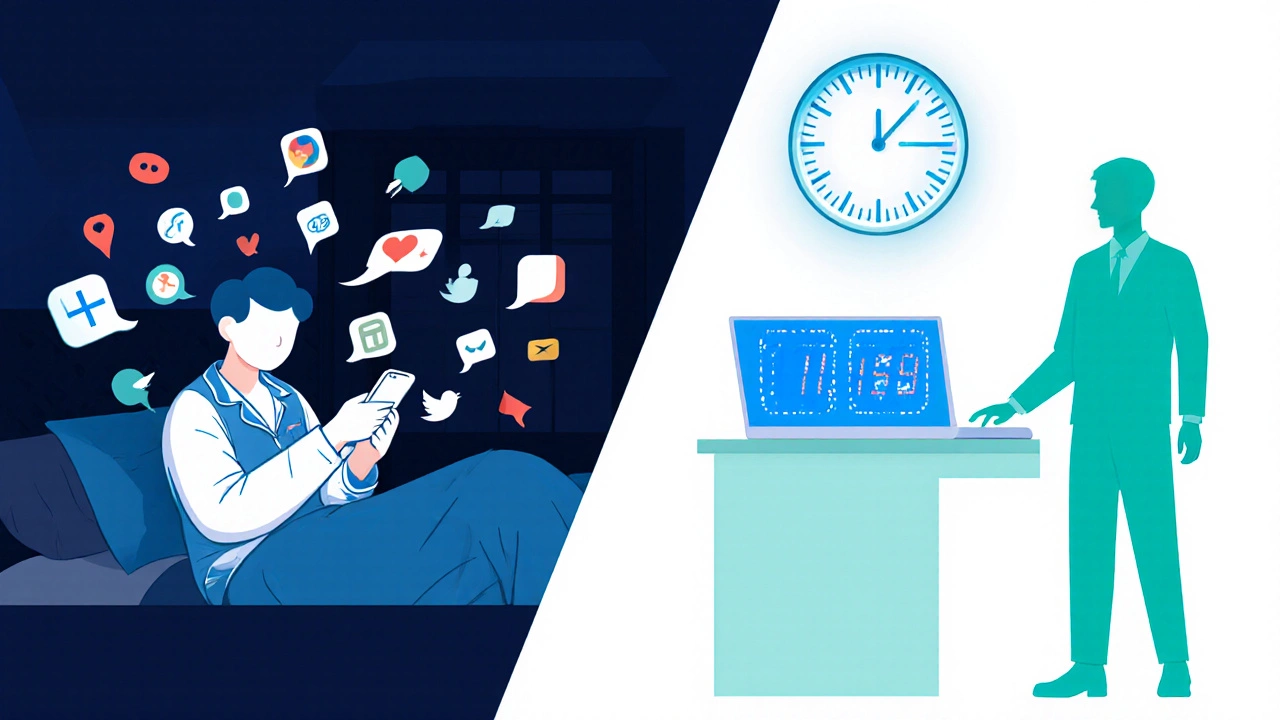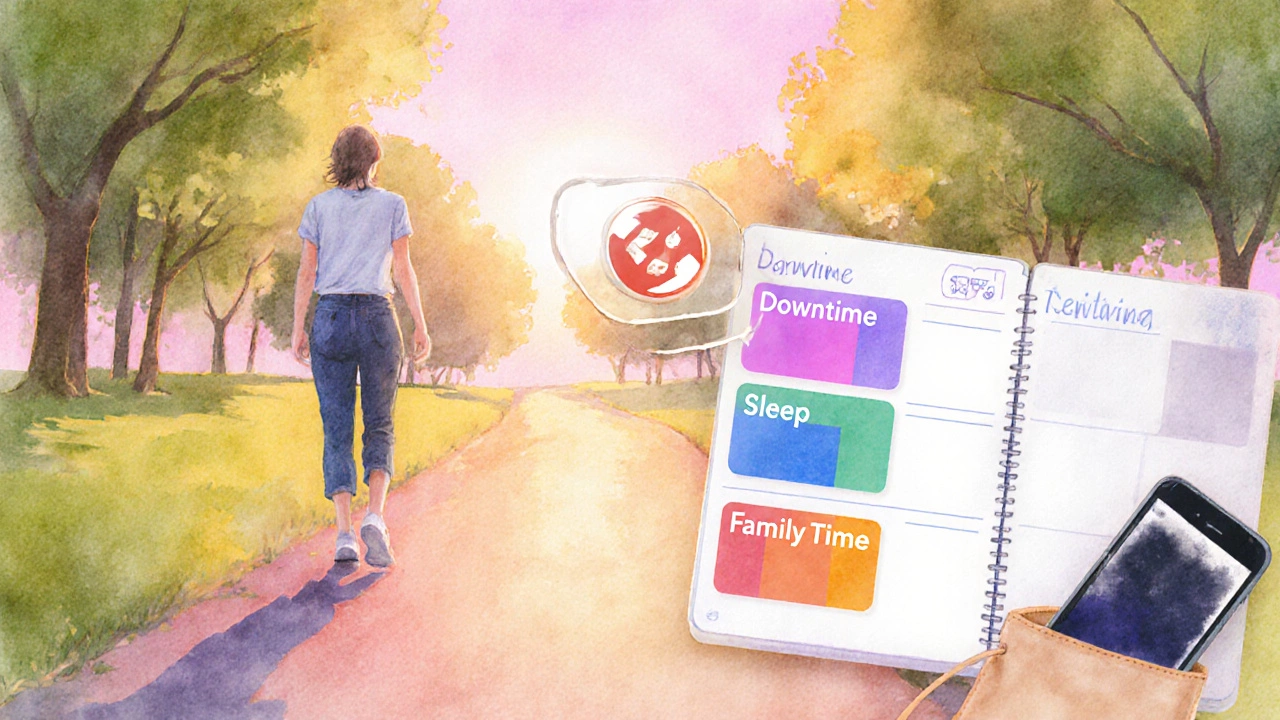Work-Life Balance Assessment
This tool helps you evaluate your current work-life balance. Answer the following questions honestly to get personalized insights.
Click "Assess My Balance" to see your evaluation.
Quick Takeaways
- An unhealthy work-life balance means work consistently eclipses personal time, leading to chronic stress.
- Key red flags include exhaustion, sleep problems, strained relationships, and dropping productivity.
- Root causes often involve unrealistic expectations, poor boundary setting, and a culture that rewards over‑hours.
- Addressing the issue requires clear limits, purposeful downtime, and supportive workplace policies.
- Regularly reassessing your balance prevents burnout and sustains long‑term wellbeing.
Understanding Unhealthy Work‑Life Balance
When people talk about a "balance" between work and life, they usually picture a seesaw that stays roughly level. Unhealthy work‑life balance is a state where professional demands dominate personal time, eroding mental, physical, and social health. This isn’t just a fleeting feeling of being busy; it’s a persistent pattern that creeps into evenings, weekends, and even vacations. The result is a feedback loop: longer hours increase fatigue, which reduces efficiency, prompting even longer hours.
Understanding the problem starts with recognizing that work‑life balance is a spectrum, not a binary switch. On one end, a healthy balance lets you meet professional goals while still having energy for family, hobbies, and self‑care. On the other, the unhealthy side shows up as relentless schedule pressure, missed meals, and a constant mental preoccupation with work tasks.
Common Signs & Red Flags
Spotting an unhealthy balance early can spare you months of needless stress. Look for these observable symptoms:
- Persistent fatigue even after a full night’s sleep.
- Frequent headaches, muscle tension, or digestive upset.
- Difficulty disengaging from work emails or notifications after hours.
- Declining quality of relationships - spouse, friends, or children feel neglected.
- Reduced concentration, leading to mistakes or missed deadlines.
- Feeling “guilty” when taking a break or using vacation days.
These signs often overlap with burnout, a more severe stage where emotional exhaustion and cynicism become entrenched. If you recognize several of these markers, it’s time to intervene before burnout sets in.

Root Causes Behind the Imbalance
Why does the balance tip? A few underlying drivers appear repeatedly across industries:
- Unrealistic workload expectations: Tight deadlines and understaffed teams push employees to work overtime.
- Lack of clear boundaries: When managers expect replies at midnight, the line between work and personal time blurs.
- Remote‑work culture: Working from home can eliminate the physical cue of “leaving the office,” making work hours feel endless.
- Performance‑driven incentives: Bonuses tied to hours logged encourage presenteeism.
- Personal perfectionism: Individuals who set excessively high standards often over‑commit.
Each cause interacts with related entities such as stress (psychological response), mental health (overall wellbeing), and productivity (the very metric companies chase). Recognizing the specific driver in your situation helps you choose the right remedy.
Impact on Health & Performance
When the balance skews, consequences ripple across multiple life domains:
- Physical health: Chronic stress raises cortisol, weakening immune response and increasing risk of cardiovascular disease.
- Mental health: Anxiety, depression, and reduced resilience are common outcomes of sustained overwork.
- Work performance: Ironically, longer hours often lead to lower output per hour, higher error rates, and diminished creativity.
- Relationships: Missed events and emotional unavailability erode trust with partners and children.
- Financial cost: Health expenses rise, while turnover costs climb for employers losing burned‑out staff.
Data from the 2024 Global Workplace Survey showed that employees reporting an unhealthy balance were 42% more likely to take sick leave and 27% less likely to receive a promotion within two years. The numbers prove that balance isn’t a “nice‑to‑have” - it’s a performance driver.
How to Reset the Balance: Practical Steps
Rebalancing isn’t a one‑size‑fits‑all prescription. Below is a proven framework that works for individuals and teams alike:
- Audit your time. Track work and non‑work activities for one week. Identify patterns where work spills into personal hours.
- Set hard stop times. Choose a daily cutoff (e.g., 7p.m.) after which you stop checking email. Communicate this boundary to colleagues.
- Schedule downtime. Block “recharge” slots on your calendar the same way you would a meeting - even if it’s just a 30‑minute walk.
- Negotiate workload. Discuss realistic deliverables with your manager. Propose redistributing tasks or extending timelines when needed.
- Leverage technology wisely. Use “do not disturb” modes, email filters, and task‑management tools to limit interruptions after hours.
- Prioritize sleep. Aim for 7-9hours nightly. Poor sleep amplifies stress and reduces decision‑making ability.
- Build supportive habits. Join a peer‑support group, practice mindfulness, or engage in hobbies that create a clear mental break from work.
Employers can reinforce these habits by offering flexible scheduling, encouraging regular breaks, and modeling healthy behavior from leadership.

Healthy vs. Unhealthy Work‑Life Balance
| Aspect | Healthy Balance | Unhealthy Balance |
|---|---|---|
| Average weekly work hours | 35‑45 hrs | 50+ hrs |
| Stress level (1‑10) | 3‑4 | 7‑9 |
| Sleep quality | 7‑9 hrs, restorative | 5‑6 hrs, fragmented |
| Productivity per hour | High (focused) | Low (fatigued) |
| Personal satisfaction | Positive, engaged | Guilty, disengaged |
| Health outcomes | Stable weight, low blood pressure | Weight gain, elevated blood pressure |
The table highlights that the unhealthy side isn’t merely about “more hours.” It’s a cascade of stress, poor sleep, and dwindling output that feeds back into longer hours-a vicious circle you can break with the steps above.
Frequently Asked Questions
How do I know if I'm already burnt out?
Burnout shows up as emotional exhaustion, cynicism toward work, and a sense of reduced accomplishment. If you feel detached, dread workdays, and notice a drop in performance, you’re likely beyond an unhealthy balance and into burnout territory. Seek professional help and take a significant break.
Can remote work improve my work‑life balance?
Remote work can help by cutting commute time, but only if you set firm boundaries. Without a clear end‑of‑day routine, you may end up working later. Treat your home office like a separate workplace and lock the door at a set hour.
What role does my manager play in fixing the imbalance?
Leaders set the tone. When managers model reasonable hours, respect after‑hours boundaries, and prioritize outcomes over time logged, teams follow suit. Open dialogue about workload and realistic deadlines is essential.
Is it okay to say no to extra projects?
Yes. Declining additional work when you’re at capacity protects quality and prevents overload. Frame your response with a brief explanation and suggest alternative timelines or resources.
How often should I reassess my work‑life balance?
A quarterly review works well. Look at your time logs, stress levels, and personal satisfaction. Adjust boundaries or habits before small issues snowball.
Next Steps & Troubleshooting
If you’ve tried the steps above and still feel swamped, consider these deeper interventions:
- Professional coaching: A coach can help you prioritize tasks and negotiate expectations.
- Medical assessment: Persistent fatigue may signal underlying health conditions requiring treatment.
- Job redesign: In extreme cases, a role change or part‑time schedule might be necessary.
Remember, achieving balance is a continuous process, not a one‑time fix. Keep the conversation open with your manager, family, and yourself. A small tweak today can prevent a crisis tomorrow.







